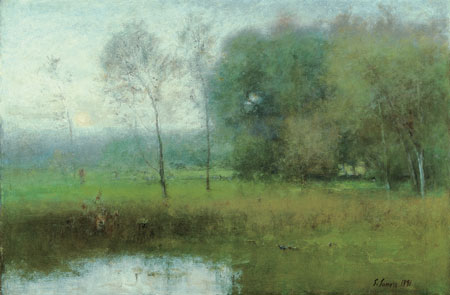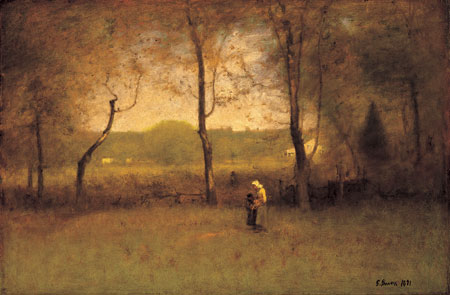Previous: James and Ann Walsh (29)
Next: Homer and Sargent at the Clark (10)
Like Breath on Glass
Post #1239 • September 30, 2008, 12:32 PM • 5 Comments
Williamstown, MA - Like Breath on Glass, currently up at the Clark, accomplishes exactly what a smartly themed show ought to achieve - playing to the strengths of the masters in a way that elevates some minor artists in the stylistic vicinity. Whistler's soft painting inspired younger painters across civilized America to attempt similar foggy handling of oils. Meanwhile, Inness's Swedenborg-flavored spirituality and his knack for working a roughly woven canvas with glazes produced an equivalent effect. (Although critics at the time attributed the style to a dissolute character.) Both of them look striking in this exhibition, particularly where Whislter's Nocturnes hang side by side. Among the elevated are Eduard Steichen, who by himself comes off a bit spooky, but here can be seen to have generated an evocatively limpid, brush-free style. Twachtman produced some Whistlerian landscapes that foreshadow Fairfield Porter in their economy and gentle palette. Aside from Thomas Wilmer Dewing, whose maidens cavort in a New Hampshire landscape rendered as grass soup, everybody gets a bump, including painters worth knowing like Emil Carlsen.

George Inness: Home at Montclair, 1892, oil on canvas, 30 1/8 x 45 inches, Sterling and Francine Clark Art Institute, Williamstown, Massachusetts

George Inness: Summer, Montclair (New Jersey Landscape), 1891, oil on canvas, 30 1/4 x 45 inches, Collection of Mr. & Mrs. Frank Martucci

George Inness: Wood Gatherers: An Autumn Afternoon, 1891, oil on canvas, 30 x 45 1/8 inches, Sterling and Francine Clark Art Institute, Williamstown, Massachusetts
2.
September 30, 2008, 1:18 PM
"Shades of Corot." Well said - beautiful paintings!
3.
September 30, 2008, 1:58 PM
yeah corot in handling and execution, but more color range from impressionists and less brown green greys of corot.
4.
September 30, 2008, 4:23 PM
eptember 25, 2008
NY Review of Books
Andrew Butterfield, the Genuius of George Inness
"As a painter, Inness matured very slowly. Although a professional artist around New York and Boston most of his life, he did not become a consistently interesting and inventive painter until he was almost forty; he became a daring experimentalist at fifty, and a radical and visionary at sixty, making his most original and thrilling pictures in the last years of his life before his death in 1894."
"The key to his new vigor was his bold rejection of the empirical standards of representational painting, an exceptional departure at the time."
"In the 1870s and 1880s, he sometimes intentionally accentuated the unreal character of the space in order to heighten his paintings' eerie effect. In the strangest of these pictures, such as Pool in the Woods from around 1890, Inness includes so few markers of relative position that the foreground and middle ground seem to shift and shimmer as if in some frightening hallucination. Describing a moment of spiritual ecstacy in the presence of the divine splendor of nature, Beecher wrote, "The whole world stood in an unnatural trance and the most familiar things looked wild and almost fearful."
5.
September 30, 2008, 11:51 PM
That is promising to read-"matured slowly These paintings are beautiful
1.
Jack
September 30, 2008, 12:50 PM
Shades of Corot. Lovely stuff.